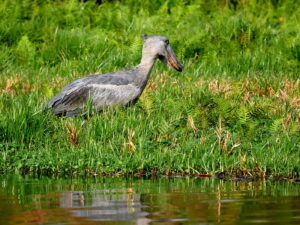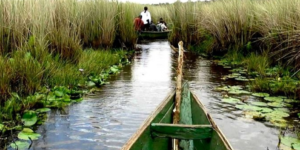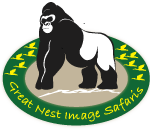Mabamba Swamp Exploration
Mabamba swamp Exploration : The swamp is famous for the shoebill with over 12 shoebill storks (locally called “Boolwe”). Besides, the bird is Uganda’s most sought-after bird by Uganda birding tourists as well as nature lovers. The swamp is generally a prime wetland birding site located on the northern fringes of Lake Victoria in Uganda. It covers 2424 ha with thick marshes of papyrus, water lilies and other wetland grasses.
 As a matter of fact, the mysterious shoebill is known to occur in mainly four countries. These include; Uganda, Rwanda, South Sudan and Zambia. However, in Uganda it is best seen at Mabamba swamp. In 2006, the Ramsar Convention on the wetlands awarded this swamp the status of a wetland of international importance since it contains globally threatened species. The wetland is also a Ramsar site and Important Bird Area (IBA) which hosts over 300 bird species. The wetland also hosts huge flocks of Palearctic migrants every year from October to March.
As a matter of fact, the mysterious shoebill is known to occur in mainly four countries. These include; Uganda, Rwanda, South Sudan and Zambia. However, in Uganda it is best seen at Mabamba swamp. In 2006, the Ramsar Convention on the wetlands awarded this swamp the status of a wetland of international importance since it contains globally threatened species. The wetland is also a Ramsar site and Important Bird Area (IBA) which hosts over 300 bird species. The wetland also hosts huge flocks of Palearctic migrants every year from October to March.
Activities done at Mabamba Swamp
Canoeing
Basically, birding in this place is done on a canoe by riding through a maze of trails cutting through the thick marshes in such for bird species. Some of the birds include the rare shoebill, white-winged warble, blue swallow, black-headed weaver. Papyrus gonolek, swamp flycatcher, pallid harrier, pigmy goose, Carruthers cisticola, lesser jacana, grosbeak weaver. Viellot’s weaver, northern brown-throated weaver, Clarke’s weaver, palm-nut vulture. Papyrus yellow warbler, African purple swamp hen, African water rail, blue breasted bee-eater. Winding cisticola, goliath Heron, African fish eagle, long tailed cormorant, yellow billed duck, malachite kingfisher. Glossy ibis, white-winged tern, hamerkop, great cormorant, grey-headed gull. White-faced whistling-duck, knob-billed duck, little stint to mention but a few.

While here, you will meet the local fishermen and discover that there was a time when the local community used to be enemies with the birds as they competed for the same fish resource. But today, many local people have been trained as tour guides who now strive to preserve both the birds and the swamp. Otherwise, guides are now a part of the Mabamba Wetland Eco-Tourism Association. They share their knowledge of the swamp and part of the revenue from their tours is re-invested in conservation projects which protect the Shoebill.
Fishing
The community is happy to tell you a story about how this Swamp got its name after a lungfish locally known as “Emamba” which inhabit its waters, and they form the staple of the shoebill’s diet. The swamp is rich with lungfish locally known as “emamba” which is also the favorite food for the shoebill. However, the lungfish is also one of the most sought-after fish by the local fishermen, creating competition with the shoebill. These fishermen had long held a superstition that seeing a shoebill resulted in a poor catch that day so they hunted and killed them leading to the decline in their number and almost rendered them extinct in the wetland.
Others
The site supports a lucrative fisheries activity and a source of fish for home consumption and commercial use. It provides raw materials for local crafts, building materials, water for domestic and livestock use and non-wood products. Factors needing attention are the dry season incursion into the swamp by fishermen; hunting of the sitatunga by the local people; the proliferation of the Water Hyacinth and poaching of the Shoebill. The proliferation of flower farms along the shores of Lake Victoria and the use of agrochemicals is likely to have an impact.
Best time to visit
This place in Uganda is visited all year round but dry months are much preferred as the water levels are low. This also gives much better feeding places and the grass is short. This is in the months of June to September and December to February.
How to get there
Mabamba swamp can be accessed by water and road. From Kampala city or Entebbe town, but the easiest route is through Nakiwogo landing site in Entebbe. You will take a motorized boat to the island led by a guide to search for the elusive shoebill. The easiest route is through Nakiwogo landing site in Entebbe where you take a motorized boat to the swamp.






